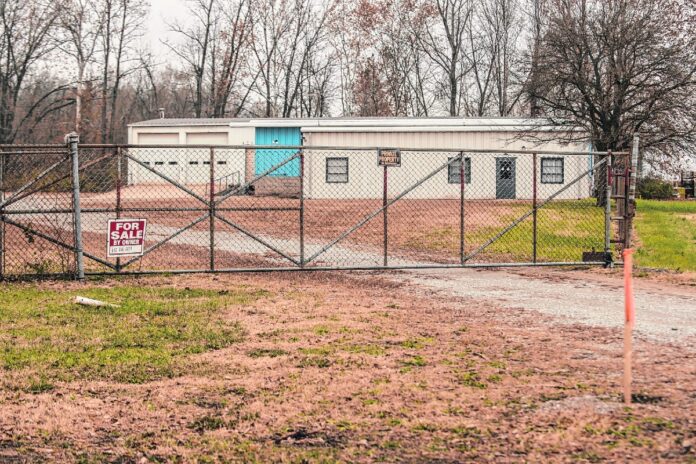
Columbus Parks Board members have approved the purchase of an environmentally-contaminated former industrial site on Jackson Street that is owned by Columbus Mayor Jim Lienhoop’s aunt.
The board voted unanimously Wednesday at a special meeting at Columbus City Hall to approve an agreement to purchase the vacant former Machinery Moving Inc. site at 1360 Jackson St. for $205,000.
Earlier this year, an outside contractor hired by the city determined that soil and groundwater on the site were above state thresholds for several cancer-causing and suspected human carcinogenic petroleum hydrocarbons.
The contractor said the contaminants were likely due to three underground fuel storage tanks that were used on the property from 1972 to 1976.
The city parks department hopes to use the property to store mowers and other parks equipment closer to the downtown area.
Under the terms of the agreement, the city will pay $34,166.67 annually for six years and “will be remediating the property at its own expense,” according to the agreement.
Columbus Parks Director Mark Jones said he expects the remediation to be fully bankrolled by a grant from the Indiana Finance Authority’s Brownfields Program, a statewide program that assists in the redevelopment of brownfield properties.
The U.S. Environmental Protection Agency defines a brownfield as a “property, the expansion, redevelopment or reuse of which may be complicated by the presence or potential presence of a hazardous substance, pollutant or contaminant.”
Mayor Jim Lienhoop has recused himself from all negotiations or decisions about the building and has repeatedly referred all questions about the transaction to parks officials handling the negotiations.
After Wednesday’s meeting, Jones said Norma Lienhoop did not receive any special treatment from the city at any point during the negotiations for the sale of the property.
“This grant funding will have no out-of-pocket or up-front costs from either the city or the (Columbus) Parks and Recreation Department,” Pam Harrell, parks business services director, told board members on Wednesday. “This grant funding is only available to government entities. Properties utilizing these dollars must be in the city’s name before commitment to the project is provided by Indiana Brownfields. The purchase of this property will provide more efficiency to our park operations area.”
The Columbus Parks and Recreation Department has been seeking to purchase the 2-acre property for months. It consists of two, single-story vacant office and warehouse buildings, with an asphalt and gravel parking lot and landscaping.
Jones said the parks department hopes to use the property as a storage facility because of its proximity to downtown Columbus and other city buildings. The city currently uses a storage facility at the Columbus Air Park on the city’s north side.
A brownfields grant
Several parks board members have repeatedly said they would not purchase the property unless environmental issues from the underground storage tanks were cleaned up without using any local tax dollars.
In March, park board member John McCormick told The Republic that “there is no intention of purchasing that property unless it is a clean piece of property. If we can help the owner make that happen, not at our expense but by our connections and by our work with her, we’re happy to do that.”
On Wednesday, McCormick said that he voted to approve the purchase because he was confident grant money will be coming from the Indiana Brownfields Program to fund the remediation of the property.
“Without the information about the Brownfield (grant), I would not have approved the purchase of the property,” McCormick said Wednesday. “And understanding that we have contingency money coming from Brownfield to take care of it, I feel very comfortable with the decision. …I feel very comfortable with what we’re doing. I feel like we’ve made a good decision. We’ve done our due diligence, and it actually has turned out better than we hoped at the end of the day.”
Previous proposed purchase prices for the property were made by the city at $300,000 and then at $250,000.
In March, parks officials said the city had started searching for grants to pay for the chemical contamination cleanup.
City officials said they are “very confident” that a state grant from the Indiana Brownfields Program will pay for remediation of the site, but only if the property is in the city’s ownership — not owned by a private citizen such as Norma Lienhoop.
However, the state has yet to “determine eligibility for funding,” for the Columbus remediation, said Stephanie McFarland, spokeswoman for the Indiana Finance Authority’s Brownfields Program.
“No grant has been approved or issued at this time,” McFarland said in a statement to The Republic. “The Indiana Finance Authority’s Brownfields Program is aware the City of Columbus is working to acquire the site mentioned. Once the city confirms it has finalized the site acquisition, the IFA’s Brownfields program will begin the process to determine eligibility for funding via the Petroleum Orphan Site Initiative.”
Parks board members, for their part, said they are “very confident” about receiving the grant money, adding that they have written documentation, including emails, that show that Indiana Brownfield Program officials are “committed” to funding remediation of the property.
“I likewise have seen the email stream, all the communication between Mark (Jones) and (the Indiana) Brownfield (Program), and it’s clear to me that they’re committed to moving forward as soon as we have possession of the property,” McCormick said during the meeting.
Jones said the city is purchasing the property on Indiana Brownfield Program’s timeline to ensure no local tax money is used to pay for any remediation. Indiana Brownfields Program representatives gave the city a July deadline to complete the purchase of the Norma Lienhoop property, he said.
“We feel very confident that they’re going to work with us on this,” Jones said. “This project fits their criteria, and we feel very confident they’re ready to take the step as soon as we get the property.”
“We know there are extra steps involved to go through their process,” Jones added.
The Petroleum Orphan Sites Initiative seeks to help communities across the state address petroleum contamination caused by leaking underground storage tanks that “cannot be addressed by the party responsible for cleanup as a result of an inability-to-pay, bankruptcy or other factors,” according to the program’s website.
The funding for the initiative comes from the Indiana Department of Environmental Management’s Excess Liability Trust Fund, which is funded by an “inspection fee” that the Indiana Department of Revenue levies on every barrel of fuel, said Barry Sneed, Indiana Department of Environmental Management spokesman.
“That tax is then passed down to the consumer in the form of a $0.01 per gallon gas tax,” Sneed said.
Environmental contamination
Last year, the city hired Indianapolis-based Ark Engineering Service to conduct two environmental assessments of the Jackson Street property.
In an executive summary provided by Ark Engineering Service in Phase I and Phase II environmental reports, company officials said they did six soil borings to collect soil and groundwater samples. The company also collected wipe samples within the interior of the buildings to “evaluate for the presence and/or absence of chemical impacts to building surfaces associated with historic site maintenance and storage operations.”
Machinery Moving Inc., an industrial rigging facility, set up small and large heavy machinery at off-site factories and manufacturing facilities. Operations included transportation and storage of various types of machinery until early 2018, according to Ark.
Ark reported that the soil showed chemical impacts exceeding the Indiana Department of Environmental Management Remediation Closure Guide, Residential Migration to Groundwater Screening Levels and Residential Direct Contact Screening Levels for several petroleum hydrocarbon constituents. These included benzene, ethylbenzene, 1,2,4-trimethylbenzene, 1,3,5-trimethylbenzene, xylenes, 1-methylnaphthalene, 2-methylnaphthalene and naphthalene.
Petroleum hydrocarbon substances in the form of benzene, 1-methylnaphthalene, 2-methylnaphthalene and naphthalene were found in groundwater in amounts that exceeded IDEM’s Residential Screening Levels, the report stated.
Benzene was also found exceeding IDEM Residential Vapor Exposure Screening Levels, the report stated.
The wipe samples did not reveal chemical contamination that exceeded applicable IDEM screening parameters, the company said.
Ark officials said the soil contamination was found in two soil borings, and the groundwater contamination in one soil boring in the presumed area where the company may have had the underground storage tanks, the document states.
“Based on the results of this limited investigation, both soil and groundwater impacts do not appear to be widespread and appear to be limited to the area of the historic USTs, (underground storage tanks),” the report states.
“Although this area of impact is not widespread, additional investigation will be necessary to fully characterize the nature and horizontal extent” of the contamination, the report states.
[sc:pullout-title pullout-title=”To learn more” ][sc:pullout-text-begin]
The Petroleum Orphan Sites Initiative assists political subdivisions by investigating and undertaking corrective action at sites contaminated with petroleum from a release from an underground storage tank for which there is no viable responsible party to conduct tank removal and cleanup, according to the initiative.
For more information about the Petroleum Orphan Sites Initiative, visit brownfields.IN.gov.
[sc:pullout-text-end]




